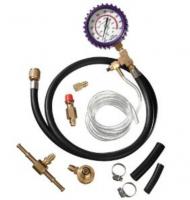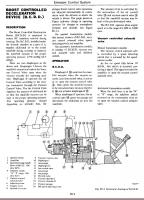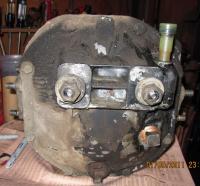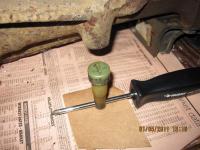Everything posted by Zed Head
-
low RPM idle and temp gauge too high
This is on the 72 240Z in your profile, right? Did it run before you installed the ZX distributor? And have you reset the timing? Your idle will drop if the timing is retarded with the new distributor. No good ideas on the high-reading gauge. Check your ground, maybe they read high as resistance goes up. One more thing - which year did the distributor come from? Your centrifugal and vacuum advance curves could now be quite a bit different from what you had before.
-
Timing mark
Too bad, I thought you were the lucky owner of four cars, plus parts. Like FastWoman suggests, I have used Liquid Paper/Whiteout to mark the notch. It seems to hold up well. I think I found mine by putting the car in high gear and slowly rolling it along the garage floor by hand so that I could make sure that I saw all of the damper pulley. You can't tell what you're missing when you try to bump it around with the starter.
-
Tranny swaps
The 77-79 5 speeds and 4 speeds used 3.54 diffs. You should check the FSM or the diff itself to be sure which ratio you have. I think that they changed ratios in the 4 speeds somewhere between 74 and 75, so might have changed diff ratios too. Edit - Agree with Fixitman. He beat me to it. Still worth double-checking what you actually have.
-
Timing mark
Which car, your profile shows four - 1973 240z, 1975 280z, 1976 280z, 1978 280z? Four cars and a spare engine. You must know what you're looking for. Might be that Arne's suggestion is where you'll end up. You can also take your distributor cap off rather than the valve cover) to see when the rotor is pointing at the number one plug wire (should be almost straight ahead ~11:30, I believe) to tell if you're on the compression stroke. Assuming that the car runs now and the distributor is installed correctly.
-
L24 Oil Feed Help
Actually, the L28s did use this tube up to late 1977, I believe, to 1976 for sure (I have one on my 1976 stock N42 head). I'm not sure when they switched to the internal oil passage cam shafts, but the N42 heads up to 1978 are worth checking. You might be able to repair yours by brazing.
- 1976 water temperature switch
-
1976 water temperature switch
This thread actually changed from the water temperature gauge sensor to the the water temperature switch at justfun13's post #28. The water temp switch is described in full at page EE-26 in the 1976 FSM. Basically, if you disconnect it - circuit open - the car will run on its normal timing both when warmed up and cold. The switch is normally closed, to run off of the other, advanced 6 degrees, magnetic pickup coil (variable reluctor) when cold. I am guessing it's to increase the idle speed up a little while cold. Mine stopped working so I just disconnected it and set the timing where it should be when warm. In theory, you could install a manual switch in place of the thermostat housing switch and run off either pickup coil. The "switch" from using one pickup coil or the other actually happens in the ignition module.
-
My 1978 280 Z car
3/4 qt. per 1000 miles is not too bad. Seafoam is a once every ten or twenty thousand miles kind of thing, it doesn't repair anything it just loosens up "stuff" that has built up over the miles. It doesn't preserve things either. I would stop with the Seafoam for now. I'm pretty sure that the previous owner of my car had Seafoam in the oil when I got it and that it was contributing to the the eye-burning exhaust. The exhaust smelled cleaner after I changed the oil. You need to get to a clean, normal baseline to work from. Your relative sounds like the sharpest mechanic that has worked on or looked at your car, of all those that you have described.
-
My 1978 280 Z car
From H to L on your dipstick is one quart. You might change the oil (no Seafoam or other additives) and start over, measuring oil consumption from a known mileage and new oil. Seafoam and other stuff dilutes the oil. I don't want to divert your thread to a "best oil" competition but I did see a reduction in oil usage when I switched from Quaker State 10-40 to Pennzoil 20-50. Most fuel pressure gauges come in a kit and look something like this - http://www.amazon.com/Actron-CP7838-Professional-Pressure-Tester/dp/B0009XQUKC/ref=sr_1_2?ie=UTF8&qid=1294694575&sr=8-2 - and cost about that much. They're usually in a bubble pack somewhere in the store. My car too stunk things up, and got bad mileage, when the fuel pressure regulator was bad. It's always good to know fuel pressure on a fuel-injection system. If your mechanics have not actually measured the fuel pressure yet, then they're not being very thorough, especially considering the symptoms you've described. Edit - FastWoman beat me again!
-
Throttle body ?
-
Car chugging/lurching, running bad.
Have you examined anything under the hood? Spark plugs, measured fuel pressure, etc. Does it run rich, with a gassy smell and smoky exhaust? Does it backfire at all? Does it miss? More data... 1,000 is actually a high idle. Spec. is 800.
-
'76 280Z Question on dist/manifold vacuum, dist timing, fuel pressure, brake booster
That is another way to get the job done. I almost went that route but I've had the whole thing out so many times I just took it out one more time, and worked with it in the engine bay (didn't want to remove the pickup coil wires). If you go that route, J2Z, don't forget to take the little screw out from the back that holds the pickup coil wires against the distributor body, if you need to. It's hard to see, but it might be difficult to get the pickup coils off if you leave it on. Another FWIW - I just bought a salvage yard distributor a few days ago, because it was there, and cheap, and in decent shape, that had the same curves as my original 76 distributor. I took the breaker plate apart, cleaned it up, put the whole thing back together and installed it. My mixed parts 1978 Frankendistributor worked okay but had a marginal breaker plate. So I'm back to 1976 stock parts now. I'm running about 16 degrees of static advance and really like the way it runs. I use 92 octane fuel and hear no signs of knocking or pinging, although it is fairly cold here right now. I think of my car as a rolling experiment though, so keep that in mind once you get everything working right on your car. Any silicone sealant should be fine between the master cylinder and booster, and might not even be necessary. I seem to recall though that there was no sealant at the bottom when I took mine off. I reasoned that it was left out so that if your master leaks, the fluid will have somewhere to go besides back in to the booster, plus you will see signs of the leakage. It's up in a dry spot in the engine compartment anyway. I didn't seal mine, although I did seal the booster to the firewall.
-
240 alt swap questions?
Here is the latest on the "issue." - http://www.classiczcars.com/forums/showthread.php?t=39259 You don't have to compromise the harness. You can make your own jumpers at the harness plug. That is essentially what the adapter does, plus it comes with a diode pre-installed to prevent run-on. Atlanticz and zcarcreations both have write-ups on doing your own harness modifications, but the adapter seems like the easiest, cleanest way to go.
-
New here, stalling and brake issues.
1975 has the fuel pump contact switch in the AFM (Air Flow Meter, not maf). It might be that after the car warms up and the idle drops down (because your Auxiliary Air Regulator is working, a good thing) the contacts are opening, killing power to the pump. My 1976 used to do that and I also could hear the relay clicking. When it got close to dying, you could hear the relay clicking on and off, in time to give it some gas. My problem was a poorly adjusted rebuilt AFM, but if your car has been sitting you probably have other issues. I would look for vacuum leaks in the intake system, which would be letting air around the AFM. The system is designed to have all air come through the AFM. Short term, you could just turn the idle up high enough to keep the AFM flapper off the contact, while you look for leaks and tune it up. The Engine Fuel (EF) section of the FSM is well worth reading - http://www.xenons30.com/reference.html
-
'76 280Z Question on dist/manifold vacuum, dist timing, fuel pressure, brake booster
You could make a 280ZX distributor work, but the only way to save money would be to get it from a salvage yard. They are very expensive. But it would probably have the same problems that yours does now. 34 years old is not that different than 31. After 1980, the advance curves changes a lot as all cars got EGR, cats, and computer controlled timing. I missed a couple of things in my last post - you can probably keep the vacuum canister that you have now. The mechanical advance might be different but you can work with it. The stores just want the distributor body for a core, and it's usually not the canister that's bad, it's the bearings in the breaker plate. Unfortunately, I've only seen one place that sells breaker plates and they were very expensive too. Also, rather than take the breaker plate apart, you might be able to free it up just by spraying some WD-40 or similar on the moving parts (six ball bearings) and wiping the rust and crud off with a rag. If it is the vacuum canister that's messed up (leaking), then the salvage yard is the place to go, or someone out here might send you one for free or a small price. They're floating around everywhere, still attached to their old gummed up distributors. Have you had the distributor out yet? It comes out with one screw, the timing adjustment screw. Just remove that screw, take the wires out of their holders along the frame, remove or free up the vacuum hose and slide it out. If you want to take it all the way off, disconnect the green, red and tan wires from the black plastic junction area, and take the whole thing out. The wire ends are sized so they only go on one way so you can't really get lost there. You can leave the cap and plug wires hanging in the engine bay. There's a few words...
-
'76 280Z Question on dist/manifold vacuum, dist timing, fuel pressure, brake booster
I'm no expert on timing curves. I just know that Datsun/Nissan tried a lot of different things over the years, probably trying to meet emissions standards and keep as much performance as they could. And a lot of those options aren't available from the auto parts stores anymore. They're not even available from the Z car focused shops either. Before you buy a new distributor you might try taking it apart and seeing if the plastic bearing race is broken. If it's not, it is fairly easy to take the breaker plate apart, clean it up, regrease the ball bearings and put it back together. There is a thin metal circlip that holds the whole stack of parts on the breaker plate. If the bearing race is broken (you'll see a crack in it and the ball bearings will be trying to squeeze out from under the metal plate) then a new one is probably worth it. Vacuum advance will give good response at part throttle operation and better gas mileage. If you decide to try it, take pictures or draw a diagram of what it looked like when you started! It's easy to get things swapped around and there is no real logic to how the plates and pieces go together. Worst case, you end up with a pile of parts you can't get back together and you buy the new distributor you were going to buy anyway. I would guess that the Cardone distributors have conservative curves just to avoid problems for their customers.
-
No start & electrical issues
Yeah, I know, but this just doesn't seem like the right place for that kind of innuendo. I'm trying to focus on cars here!
-
No start & electrical issues
SSBB, any chance you could change your screen name? It's really unpleasant to look at. Not even sure why someone would do that...
-
Is this rear suspension part bent?
Actually, I'm pretty sure that that is not an R200. Maybe the grease and grime is obscuring the view. Here is a picture of mine, from a 76 280Z manual. Bigger and bulkier with a more rounded shape, fill plug is more offset and so is the breather vent. There is a big difference between cygnusx1's curved cross-brace with transverse link caps and rscottm's combined cap and cross-brace. I assume that rscottm has the early forward-mounted diff, with the potential vibration issues? I'm a 280 guy for now so can't really speak to how the 240s are supposed to look.
-
Modified harness/engine won't shut off
Actually, they used the external regulator up to 1977 (I did the ZX internal regulator alt swap on my 76). I think the diode is need with the ammeter, which passes current, as opposed to the voltmeter, which doesn't. When did they go to voltmeters? Either way, I found this link - http://www.zcarcreations.com/howto/voltreg.htm - which says it's the L wire, if you need it.
-
'76 280Z Question on dist/manifold vacuum, dist timing, fuel pressure, brake booster
A three minute reply (when I started)! Must be cold and rainy in Oregon (where I am). I thought that you said you were buying a new Autozone distributor back in Post #71? So I'm just suggesting being conservative until you know more about the advance curves on the new one. I don't know if you run Premium or Regular either (I'm assuming Premium?). If you give it too much static advance and you have aggressive advance curves and you ran Regular, you could get some knocking at part-throttle or wide open. There were a wide variety of advance curves used for the different years of Z cars, and I've noticed the auto parts stores going with "close enough" for some parts (they call it SKU - Stock Keeping Unit - reduction in the business world, it saves money). Just look at the "compatibility" option on OReilly's web site. I'm running 17 degrees on mine but I did get a bad tank of gas once and got a little bit of knocking at part throttle. But I also have a 78 mechanical curve with a 76 vacuum (Frankendistributor). 14 static would give you 34 total on a 1976 curve, so you're probably fine there. I can't tell if you're trying to get back to stock or if you're up for modifying until it runs the way you want it to. Either way is good, FW and cozye can get you there. Edit - I actually started this before your last post...
-
Differential breather leak
Here is a picture of the breather vent from a 1976 R200. The screwdriver goes through the hole at the bottom. The stepped down portion is a press fit in to the breather hole. Same effect, arrow pointing forward or backward. In general, I have found that arrows are usually meant to point forward. There has to be some "breather vent install instructions" out there somewhere! p.s. I crawled under my car and found that the arrow on that breather points sideways as noted above. I forgot to look at the one in this picture (it's a spare), I pried it out then noticed the arrow. Bonus finding though - my fill plug could be tightened an extra turn and might have been contributing to the oily mess. Edit - amusing coincidence - here's a 71 R180 with the arrow pointing forward, post #9 pictures (you might have to view it and blow it up to see it) - http://www.classiczcars.com/forums/showthread.php?threadid=40824
-
'76 280Z Question on dist/manifold vacuum, dist timing, fuel pressure, brake booster
j280Z, not really sure what you're saying here, but anyway, the vacuum and centrifugal advance happens inside the distributor (at your shiny new breaker plate with new ball bearings). The factory static advance (no vac or centrifugal/mechanical movement) should be 7 degrees, 1976, engine warmed up. That is what you are setting by rotating the distributor body at idle. Although, it is fairly common to run a few more degrees static advance. The vacuum and centrifugal advances are not really "tunable" but can be changed with a little work. It would be interesting to know what your reman distributor has for these two, since I am pretty sure the reman companies standardized on some middle of the road numbers, as shown by their "compatibility" between many models that had different advance curves from the factory. Anyway, for starters, you should probably set your static timing at 7 degrees per the FSM (10 degrees for CA model), especially since you may have been driving it with stuck advance mechanisms on your old distributor.
-
260Z Transmission - Keep, Sell or Toss
If it's been in storage since the 80s then it has lower miles on it than most, a good thing. But there are 4 speeds for sale all over the place, as people take them out in favor of 5 speeds. Check CL in your area, or just throw an ad up. Someone might buy it just for the low mileage. I have a 4 speed in my garage myself, keeping it as a spare. I replaced it with a 5 speed.
-
Brake lights not working!!
You can narrow things down with a test light or volt meter. You should have power at the brake switch all the time. The wires are (relatively) easy to get to. Just test both wires to ground, with the pedal down and the pedal up. If you don't have 12 volts on at least one wire with the pedal up (switch open) work your way toward the battery. If you have power on one wire, but you don't get ~12 volts on the both wires with the pedal down,then your switch needs work. If you get power to both wires with pedal down then work your way toward the lights.







